#forgetting there’s a jump that is basically impossible without the float ability
Explore tagged Tumblr posts
Text
13 hours into my second Watcher playthrough and perhaps I was too harsh to Signal Spires and Verdant Waterways and All of Aether Ridge… but not Badlands fuck that place
I’ve also not even set foot in Coral Caves yet but I’ve JUST made it to Desolate Tract so I should be able to get there via Rusted Wreaks booyeah!
#rain world#rain world the watcher#the watcher dlc#rain world watcher#rw watcher spoilers#rain world watcher spoilers#rainworld spoilers#rain world spoilers#watcher dlc#I started in sunlit port this time and like a dumb fuck decided to go aether ridge first#forgetting there’s a jump that is basically impossible without the float ability#so I got stuck there unable to get to coral caves#I wanna keep the rot as contained as possible so starting in sunlit is perfect bc it has two connections only#and I can circumvent it by just going around#anyways I’m at max karma now so I can get the ancient urban ending whenever
7 notes
·
View notes
Text
Okay people, time to talk about how Asgard makes no sense at all!
(I'm no astrophysicist or anything of the like, I just find all of that fascinating and therefore take the time to learn more about it. I can't go into the math or anything but I know the concepts of things).
Today we're talking about how gravity is so unbelievably inconsistent on Asgard and makes no sense!
Before we begin, let me define gravity. I know, you learned about it a million times in school, but there are things we forget about it. Gravity is a force that attracts objects with mass to each other. For example, the Earth has mass and therefore has a gravitational field pulling you to the core. You also have mass and have a gravitational field and are pulling the Earth towards you. But the Earth is much more massive than you, making your gravitational field basically negligible. Everything with mass has a gravitational field, and those interact with nearby objects. For example, there are gravitational interactions between you and the phone/computer/tablet you are reading this on.
The more mass something has, the stronger the gravitational field. That is why we stay on the surface, and why planets stay in orbit, and why black holes "suck" ("suck" is not a very good word to describe the process, but oh well) different objects in, and why galaxies hold together.
The center of gravity is created by two gravitational fields interacting. With you and the Earth, the center of gravity is almost exactly the exact center of the Earth. Not quite, but extremely close, because of how much more massive the Earth is. While objects with more similar mass have the center of gravity closer to the middle. For example, Charon, Pluto's moon, is about half the size or so of Pluto. The center of gravity between them is actually above the surface of Pluto. It's closer to Pluto than Charon, but their mass is so similar that they're actually both orbiting around a point in space.
Now that we have that out of the way, here we go under the cut because this is a massive post.
1) The planet's form makes absolutely no sense
Look at this!
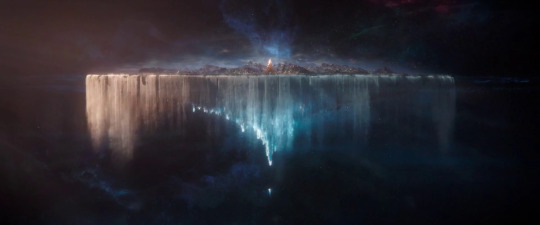
What even is this? Asgard is a disk with an iceberg-esque part at the bottom and some land mass on the top. Which is problematic.
For one, gravity causes things to become spherical. Things, such as yourself, with lower mass don't have the gravity to become a sphere. This is why asteroids and some moons can have funky shapes.
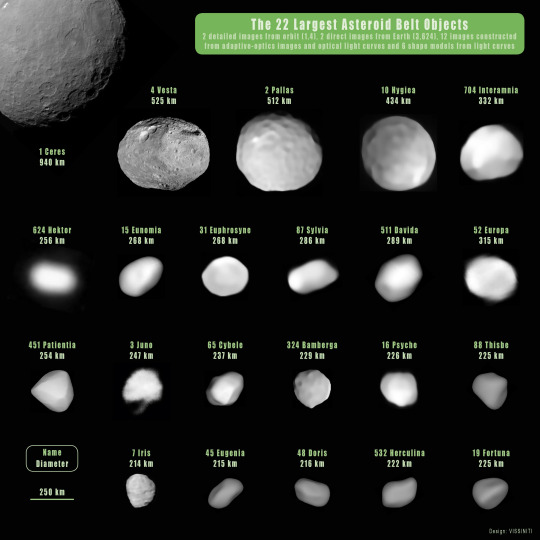
Here are some asteroids. Ceres is the biggest asteroid and a dwarf planet, and it is almost spherical as you can see. The rest are a little funky. They don't have the mass, and therefore gravitational force, to be spherical.
Life evolves to live in the conditions it is in. We can't see ultraviolet light because our atmosphere blocks most of it. So why would we need that ability? Why would people that could see UV have a higher chance of surviving to reproduce? This is why we aren't ridiculously strong. We evolved to be able to work with what was needed. Which means we are suited for Earth's gravity. If it weren't for other factors like the suits, astronauts would be able to jump much higher on the moon because it is tiny compared to Earth, and our strength overcompensates.
If Asgard has low gravity, then it would make sense Asgardians would evolve for a low gravity environment. Which means they wouldn't become super strong. If anything, they could have serious spinal problems on Earth because of our gravity, assuming they didn't immediately collapse. And, um, that is not the case in Marvel. The opposite is true.
2) Inconsistent gravity is confusing
So, gravity is what keeps us on the ground, right? Well, that doesn't always seem to be the case on Asgard.

Not to mention the water constantly spilling off (also not astronomy related but where is that water coming from? And why does that water just disappear?).
Even if Loki was about as far as he could be from the center of gravity while being on the planet, even if Asgard has extremely low gravity and they showed it to us, this would still make no sense. Gravity should be strong enough to keep him on the planet.
And if it wasn't? Should've not been strong enough everywhere else on the planet. No one should be able to stay on the planet. It shouldn't be strong enough to have an atmosphere.
While with its shape Asgard would have unequal gravity, it shouldn't be this unequal. And, if gravity were weak enough for Loki to fall off, it should've been weak enough that he would've floated off rather than fallen off. Same with Thor. And Odin. And Heimdall. And literally everyone else to ever be on the bifrost. No one should be able to stand on the bifrost, everyone should float off into orbit. But that clearly doesn't happen because Asgard's gravity makes no sense.
3) 2+ nearby wormholes
There are at least two nearby natural wormholes.

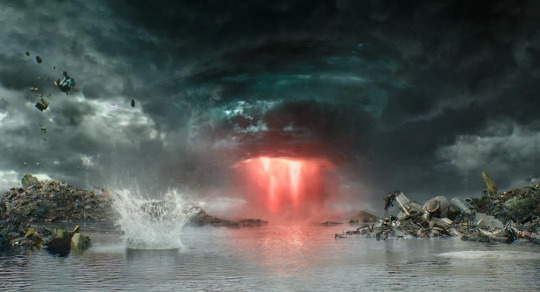
We have a wormhole taking you from Asgard to Sanctuary and a wormhole taking you from Sakaar to Asgard. I am not including the bifrost, because while Selvig and Jane called it an Einstein-Rosen bridge (sciency way of saying wormhole), the bifrost is artificial, and not naturally occurring. Right now I am focusing on the naturally occurring wormholes. Also, we don't know if these are two way wormholes are blackhole whitehole pairs. Basically, the theory is that some wormholes could allow travel from both ends, kind of like the Nether Portal in Minecraft, and others are a one way ticket, with a blackhole on one end and whitehole (ejects mass instead of taking mass in) on the other. We've only seen these work one way, so they could be partially whiteholes.
So there are a few problems with all of this.
Blackholes distort light.

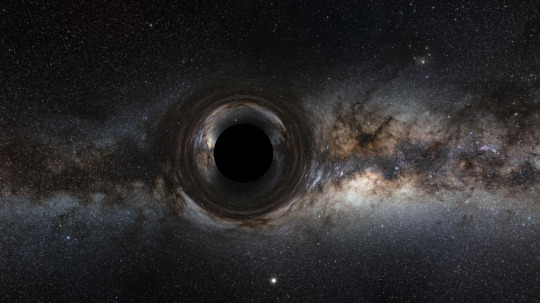
The top image is from Hubble. Do you see the circular-ness the photo is focused on? That is from a blackhole distorting light. The second is an illustration and not from Hubble so it's less reliable, but this is a more noticeable example. Basically, light has particles called photons, and blackholes absorb mass.

As you can see in the gif, stuff orbits around blackholes and slowly gets closer and closer to the event horizon. Once you get past the event horizon, there is no turning back. Light can't escape, which is why these are blackholes. Photons are distorted like this, which means that the light produced by nearby stars and reflected by nearby celestial objects is distorted, making them look off.
In other words, Asgard's light should be...interesting.
Another thing, Asgard should be orbiting around one of these blackholes to die eventually. Unless there's a bigger one, I would guess the Sakaarian wormhole if it were two way. If not, it'd orbit around the Sanctuary wormhole.
Having two next to each other would do crazy things to Asgard's gravity. The Sanctuary one would constantly be pulling Asgard towards it, and if the Sakaarian wasn't a whitehole, it would constantly be pulling Asgard and the Sanctuary wormhole towards it.
This is something I don't know as much about, but if the Sakaarian wormhole is a whitehole on Asgard's end, I would not be surprised if there were consequences. Lots of mass being ejected into the nearby space might have consequences, though this mass might be coming in subatomic forms and not be too harmful.
(Also Sakaar should've been torn apart by the wormhole leading to Asgard and possibly others. I'm just saying. This is an Asgard post but we gotta agree that Sakaar is also messed up).
Except that none of this is true apparently.
4) There is no way Loki should've survived.
When Loki fell into the wormhole he had two options: die a quick death or die a very quick death. Wormholes are awesome. Awesome in the biblical sense of the world. Which means they are utterly terrifying.
Quick Death: Loki should have been spaghettified (and also Asgard...and the Asgardians...but I'll let that slide since apparently Asgard has secret amazing gravity). Spaghettification happens as you get closer to a singularity and let me tell you, it is absolutely terrifying. It is my greatest irrational fear (irrational in that it will never happen to me). Basically the gravity of blackholes (and by extent wormholes) literally tears molecules apart. It starts with stretching the person/object out to make them long and thin, like spaghetti. A person would die during this first stage because our organs cannot handle this. And soon the body/object would fall apart on an atomic level.
Very Quick Death: Upon passing the event horizon (point of no return), Loki would go through a massive wall of fire, burning him to death and he would be spaghetiffied almost instantly.
So...yeah...how is he not dead?
5) Even if Loki could survive, he shouldn't have made it to Sanctuary
There are theories on how to make viable wormholes. I don't remember exactly how, but there are theories on how to allow someone to pass without being spaghetiffied or burnt to a crisp. But then there's the problem of it being impossible to reach the other side.
Basically the "pathway" between the two ends of a wormhole is infinitely small. In other words, Loki couldn't fit through it, and would therefore die. There are theories on how to counteract that problem, but the odds of a wormhole naturally forming like this are low. So, Loki should've died even if he got past the singularity on the way to Sanctuary.
6) Also there's the bifrost.
The bifrost is artificial. The problems about travelling through wormholes (spagettification, fire wall, infinitely small tunnel, etc) aren't there because Asgard built it as a way of travel. And since it was repaired by the Tesseract in between Avengers and Dark World, it might be a product of the Tesseract anyway.
With artificial devices explained by fictional science/technology/magic, I'm not as picky. It's science I don't understand because that's not science from this universe. But I do have questions about the bifrost. I don't fully understand how it could've destroyed Jotunheim. My thought was that it absorbed Jotunheim like a blackhole, but we don't see debris coming over to Asgard. How is it turned on and off? What consequences were there when it was destroyed? Is gravity all of the sudden strange when it turns on? I do like that it looks like people are pulled into the bifrost when it turns on, makes it more wormholey. But how did Hela knock Thor and Loki out of the bifrost?
I tend to forgive all of that because it's a fictional device. Just like how I forgive the gravity/blackhole bomb things the dark elves had. Those are clearly artificial and since we have theories on how those are possible I let it slide (though I find it interesting how the blackholes evaporate (that's the term for the death of a blackhole)). I actually headcanon the dark elves used gravitonium to create these devices. Gravitonium is an element introduced in Agents of S.H.I.E.L.D. that has interesting gravitational abilities. It is 100% fictional, so I let a lot of it slide. But gravitonium is supposed to be a heavy element, meaning it wasn't created in the solar system, it was created by a supernova, so it has to exist elsewhere in the universe. Why not on Svartalfheim? But that's just me (there are actually lots of connections between TDW and AoS, specifically connections between Loki and AoS). But fictional devices are that: fictional. Whereas blackholes and wormholes are very real. Blackholes are confirmed to exist, and wormholes are theoretical with lots of evidence (Einstein created a list of formulas describing how the universe works, and wormholes work in these formulas. But that doesn't mean wormholes exist currently, have existed in the past, or ever will exist, we just know they're theoretically possible.). So I can be more picky about those.
Of course, I can watch these movies and still be entertained. I love these movies. But I'm a nerd that has to overanalyze everything and I specifically like space, and thus this post was born because Asgard makes no sense.
#asgard#thor (2011)#thor: the dark world (2013)#thor: ragnarok (2017)#black hole#white hole#wormhole#astronomy#loki laufeyson#agents of s.h.i.e.l.d. (2013-2020)#sorry for the extremely long post#but i was bored & i have thoughts
18 notes
·
View notes
Text
Essential Avengers: Avengers #187: The Call of the Mountain Thing!

September, 1979
Still a great title.
And a pretty great cover.
Chthon!Wanda front and center with the Avengers floating upside down lightly napping around her as the sky catches fire.
Shit gonna go down, most probably.
How did we come to this?
Last time: An old man kidnapped Scarlet Witch and Quicksilver by stuffing their souls into some dolls. He was thwarted by the Avengers but the twins decided to go on vacation with the old man anyway on a journey to rediscover their mysterious origins. They traveled to their homeland of Transia, a small country between Romania and Serbia full of quaint villages and angry mobs. Modred, the Wi-Fi Wizard, lured Wanda up the mountain where he shot her in the back twice and enabled his master Chthon to possess her body. Chthon’s first order of business: put on an eviller, sexier outfit.
Meanwhile, Quicksilver fell down a mountain and right into a rich spring of exposition and retcons when he met Bova, the cow-woman midwife who helped birth him. She explained to him what his real backstory was, dropped hints that his real dad was Magneto, and cooked him a hot meal. Upon learning that Wanda is now evil and sexy, Quicksilver rescued Django Maximoff (aforementioned kidnapper and the twins real dad in terms of who actually raised them) from some trees and called the Avengers for help. But alas, Pietro and Django were exploded and then captured by the possessed Wanda.
So that brings us to now.
Which is the Avengers arriving in, or rather over, Transia.

QUINJET!
God. That is a huge windshield.
Anyway, the Avengers have arrived but the weather is still going bonkers and the Quinjet is going crazy too. Although the art doesn’t really reflect this, three engines are out and the instruments are going crazy.
So. Yeah. They’re going to crash.
In the finest tradition of Quinjets.
Cap realizes that they have to bail. Good thing that three of them can fly and one of them has a rocket belt.
Oh yeah, the roster for today is: Captain America, Ms Marvel (subbing in for Wanda), Falcon, Beast, the Wasp, and Wonder Man (subbing in for Iron Man).
We’re not very far into Gyrich’s new government mandated roster and the auxiliary Avengers have already been in more than the people he wanted.
Beast decides to stay on the Quinjet, wrestling the controls to make sure it doesn’t land on anyone.
But Wonder Man decides ‘nah.’ He picks up Beast, slaps his rocket belt on him, and throws him out of the Quinjet.
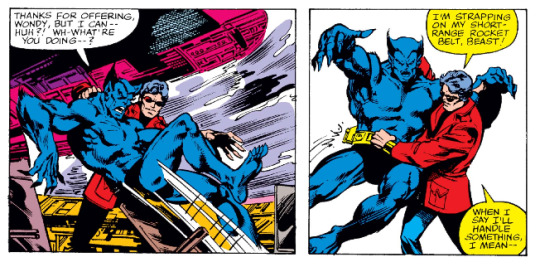
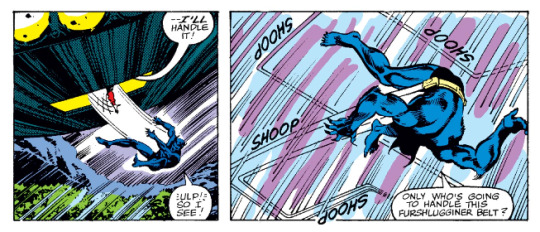
Because, hey. Wonder Man is indestructible. If anyone is going to stay at the helm of a crashing ship it makes sense for it to be him.
Beast is less than enthused. Mostly because his unfamiliarity with the rocket belt leaves him flying upside in peak comedic fashion.
Anyway, in the Quinjet, Wonder Man wrestles with the controls, having second thoughts about this brave thing he did (and good job, Wonder Man! What with your insecurities and fear of dying!).
Finally, it just becomes impossible to keep the Quinjet airborn anymore so it becomes more earthbound.
With a FWAWHOOMP.
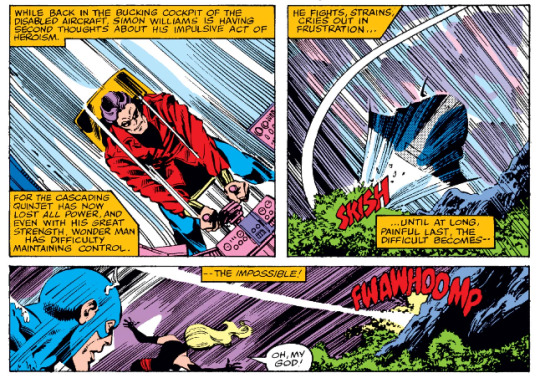
The Avengers watch the crash with Cap basically going ‘welp hope he really was indestructible anyway lets get a move on.’
In fairness, he’s either entirely okay, dead, or incredibly inconvenienced so that’s a 2/3rds chance that there’s no point in checking on him.
Cap tells the Avengers that they’ll head to the village. Its the most likely place for Quicksilver to have placed his call from.
But then Modred shoots Cap in the back.
GODDAMMIT MODRED, ALWAYS WITH THE SHOOTING IN THE BACK
Luckily Cap had his shield and even magical attack must yield but it still knocked him off his feet.
Modred the DICK tells the Avengers that he’s here to fetch them to be disciples of the great Lord Chthon but Cap says nuts to that. And also “Avengers assemble!”
Falcon and Ms Marvel are the closest so they rush Modred first. Modred responds by conjuring up a shower of rocks from the ground which Falcon finds very off-putting.
Falcon: “Wha--? Holy crud! Just when it finally stops rainin’, this dude conjures up a shower of rocks!”
Ms Marvel: “Don’t talk about it, Falcon. Just do your job!”
Falcon: “Swell. For a minute there, I forgot I was the new kid on the block. But maybe I can make an impression on these high-and-mighty Avengers -- by layin’ in the first punch!”
And Falcon has finally thrown a punch as an Avenger! Shame that he now feels that the other Avengers are looking down on him just because Ms Marvel (herself a new kid on the block) snapped at him.
Also shame that Modred completely no-sells the punch. And then uses Leaf Storm against Falcon. Despite it being a grass type move it is Super Effective anyway.
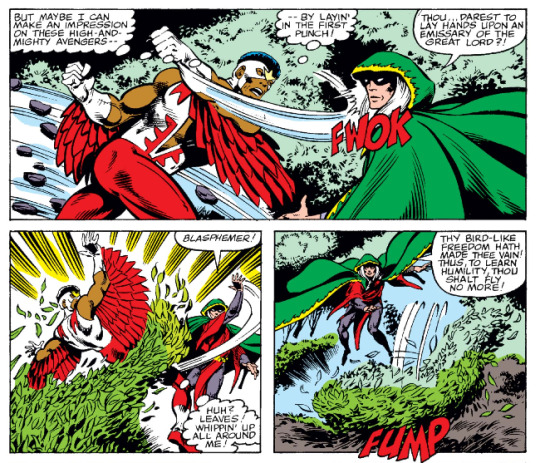
... So basically Modred gestures and a bunch of leaves just clump around Falcon until he falls over and I guess he’s out of the fight. Defeated by leaves. How ignominious his first issues have been.
Meanwhile, elsewhere: Beast was so bad at rocket belt that he actually crashes into a snowbank far away from everyone else.
Which makes me notice. None of the other Avengers wondered where he was! They were about to set off towards the village and Falcon was concerned about Wonder Man who was in the crashed Quinjet but nobody was like ‘shouldn’t Beast have joined us by now?’ or ‘should we wait for Hank McCoy, the best Hank in our lives?’
You’re not the only one going unappreciated, Falcon.
So, Beast crashes into a snowbank and spots something shiny.
Maybe its part of the Quinj-OHNOOOOOOOOPE ITS A SKULL
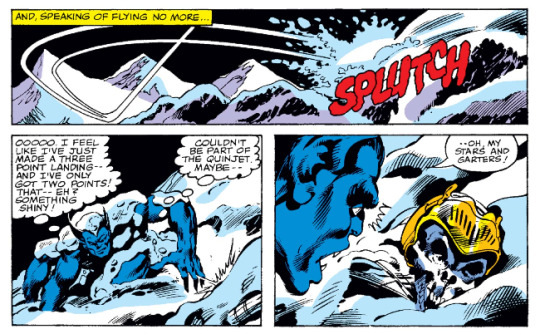
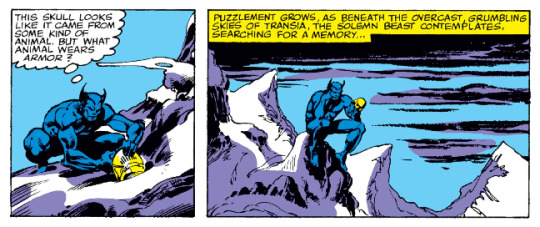
Its a non-human skull. Looks animalian even. But it was wearing armor. What a puzzlement.
And Beast sits on the side of the mountain thinkering on that puzzlement.
Meanwhile, Modred, the Wi-Fi Wizard, continues to throw rocks.
Cap can block the rocks with his mighty shield and Ms Carol Marvel is good at aerial maneuvering so she’s dodging and weaving through the motion lines towards Modred.
So instead he hits her with lightning.
Yer a jerk, Modred.
I’m a bit surprised that a single lightning bolt took her out though. In the recent Avengers Annual #8 she tanked an electrical attack by Dr. Spectrum and then punched her through the wall.
Then again, a point is made much down the line that for all of Carol Marvel’s ability to absorb and redirect energy, she has trouble with magic.
So. Sure.
Cap thinks to himself, hey, sure Modred took down Falcon and Ms. Marvel like nothing but dangit he’s up against an old war-horse full of guile and stuff.
So he cleverly throws his shield to the side, relying on its mighty boomerang-ish qualities to make Modred yield upside the back of the head.
But magic is bullshit and a tree snags Cap’s shield out of thin air.
So Cap jump kicks Modred right in the wi-fi.
The second good hit on Modred all issue. Falcon got the first. Yay, Falcon!
But just like Cap, the minor thrill of hitting this jerk is quickly eclipsed by what a jerk he is and how much bullshit magic is.
Modred hits Cap with hurricane force winds that create a vacuum so Cap can’t breath and passes out.
Also, the THWIP gesture is magical. I wonder if Spidey knows.
Meanwhile, the crashed Quinjet.
Actually crashed in largely one piece. From the FWAWHOOMP, I assumed the crash site would be worse but Wonder Man did a good job.
Although he’s not exactly thinking ‘any landing you can walk away from.’ He’s actually grousing that the FAA would take away his license if he had one. Which I’m not sure if that’s actually true. Landing a disabled plane in any reasonable shape doesn’t seem like they’d penalize it. Although flying without a license...
Anyway, Wonder Man sees a big ball of light flying towards him but he’s no sooner recognized it as Wanda (or sexy, evil Chthon!Wanda anyway) than she has paralyzed him with magic and carried him away for nefarious reasons.

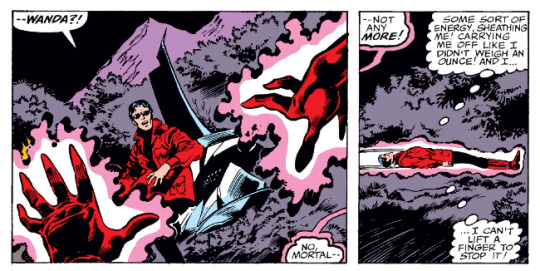
Back at the Modred and Modred gloats about having defeated all of the Avengers.
Yup. Beat Falcon with leaves, Carol with magical lightning, and Cap with a stiff breeze. With Wonder Man and Quicksilver captured by possessed Wanda and Beast thinkering on a mountain somewhere, that’s every single Avenger yesiree.
And then Wasp blasts Modred unconscious to punish him for forgetting she exists because she can’t punish the narrative or the writers. They remain forever frustratingly out of reach.
Although, She-Hulk becomes her bestie later on. Hook your bestie up with some writer punching, She-Hulk.
Wasp’s own victory is as shortlived as Modred’s as she gets shot in the back by Chthon!Wanda.
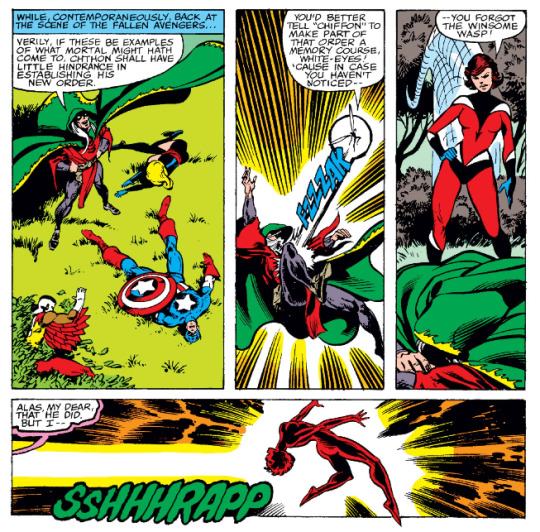
We just can’t have nice things.
Chthon!Wanda pink energy floats the defeated Avengers up Wundagore mountain and probably to where that alter was.
An alter seems a good place to do what Chthon!Wanda is getting ready to do.
Step one in conquering the world using the power of the Darkhold is creating a circle of upside-down floaty people.
Step two is doing some expositing. Why should Bova (the cow-woman midwife who delivered both the twins and some amazingly convoluted backstory in previous issues) have all the fun?

Chthon reveals (to Modred who presumably already knows?) that Chthon and his sister were the last of the Earth-Spirits that came before the gods. But while his sister infused her essence in all living things and became Mother Earth (Thor’s mom?), Chthon feared death and fled to a nether plane, leaving behind the Darkhold (scribed in words of FIRE) to provide a gateway for his eventual return.
It was not a plan without some setbacks.
Although the Darkhold is an indestructible tome that was used and miused by various people throughout the years while Chthon bided his time, in the sixth century the Darkhold was found by Morgan le Fey of Arthurian significance.
And obviously a person like Morgan le Fey when confronted with an evil book that was a gateway to a banished spirit on a nether plane would immediately try to summon said banished spirit to serve her.
So. That didn’t go well.
Upon realizing that Chthon was not, in fact, controllable as such, Morgan and co tried to shove Chthon back into the nether plane. They weren’t able to do that but at least they shoved Chthon into a mountain and decided close enough for magical work.
Around this time Magnus, a member of Morgan le Fey’s coterie, decided hey maybe this Darkhold is actually... bad news? And stole it to hide in an enchanted tower where no one with evil intent could enter.
Did you catch the immediate loophole there?
Yeah. Those with benevolent intentions could enter the tower.
Geez. This sounds like a quest in a fantasy story and/or video game. I mean, I guess this is a fantasy story. With high tech knights in a little bit but definitely fantasy. But like... this is a very Skyrim sidequest.
Anyway, Modred (before he was as much of a dick) entered the tower to use the Darkhold for good reasons and “paid for that folly with his soul!”
So I guess Chthon isn’t telling this story to Modred despite him being the only one conscious to listen to it because Chthon referred to Modred as ‘him’ instead of ‘you.’ I guess Chthon is just talking to himself.
Anyway. The Darkhold was later removed from the tower by St. Brenden and again passed through many hands through many years until it landed with Gregor Russoff. Who managed to curse his own name with the Darkhold’s evil.
He was the werewolf that I mentioned in previous posts that killed Jessica Drew’s mom.
Anyway, to fund his new hobby of EVIL, Russoff sold off part of his estate to some scientists, which included Wundagore mountain. Because people can just own mountains. Casually. People can just casually own mountains.
Obviously, one of the buyers was Herberet Wyndham, later to be known as the High Evolutionary.
The scientists found uranium in them thar hills and used that wealth to build Wundagore (the city).
Chthon was pretty confused about all this ‘science’ and ‘genetic abominations that were part man and yet part animal.’ But you don’t have to understand stuff to capitalize on it.
But Chthon wasn’t able to do that either. Magnus, the renegade tower building ex-follower of Morgan le Fey, ended up as a colleague of the High Evolutionary and taught the New Men chivalry, which rendered them unsuitable for Chthon’s purposes.
Chthon attacked Wundagore anyway, through his host the Other, but ended up vanquished “by the combined might of sixth century sorcery and twentieth century science.” And also by animal-people in armor, riding ‘atomic steeds.’
Which is. I mean. A giant screaming demon face fought with magic, technology, and the Knights of Wundagore.
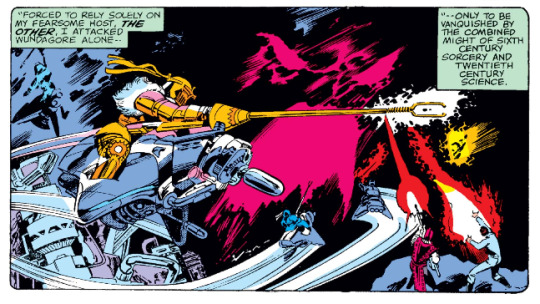
That’s a prime contender for a ‘greatest story scarcely told’ moment.
These events do seem to get fleshed out a little bit more but only in the far off year 1988 in an X-Men annual during the Evolutionary War.
But even in defeat (by animal-men taught chivalry by an ancient wizard and riding atomic hoverbikes), Chthon planned for future victory.
It just so happened that a child was born in Wundagore the night of Chthon’s defeat. And as Chthon was resealed into the mountain, he imbued baby Wanda with latent magical potential to complement her powerful mutant gift.
Way to screw everything up, Magda. You bring a fetus to a demon mountain and you wander off into the snow to die? You’re the worst.
Although I suppose a question here is why just Wanda? Why not hedge your bets and imbue both Wanda and Pietro? As we’re about to see, Chthon had to kick and scream to get Wanda to this very situation that he needed her to be in and with double babies at least he would have had options.
Well, I know the reason is that this is a development from Wanda learning magic which was a development from her codename containing witch. But in story, why did Chthon put all his eggs in the Wanda basket?
Maybe he had has his heart set on that evil, sexy outfit. But if you think Pietro couldn’t rock that ensemble, Chthon, you need to be more open-minded.
Anyway, apparently even sealed in a mountain, Chthon had enough influence over Wanda to dampen her mutant powers several times in hopes that she would decide to learn magic to make up for it.
But it was only her introduction to Agatha Harkness that Wanda learned of her magical potential. And lets not forget that she almost immediately got possessed by Mephisto there so maybe learning magic was a bad idea.
It has gotten her possessed two and a half times by this point. Mephisto, Chthon, and I’m counting the Serpent Crown as half.
Maybe Agatha Harkness should have taught her ways to defend herself against possession before declaring that there was nothing further she could teach her.
Anyway, with Wanda now knowing magic and still having her science-spawned mutant powers, she was at least worthy of being Chthon’s dual-natured host. Because if science and magic beat him once, why, he’d just combine the two for his own good! Eat it, High Evolutionary and Magnus!
The last detail of getting Modred as a servant was taken care of by contriving a battle between Modred and the Other to gain complete control over the Wi-Fi Wizard and then having Modred trick Magnus into being half a world away when Chthon rose again.
Chthon!Wanda: “And now I have completely subjugated the soul of Wanda Frank, her body, her scientific and sorcerous abilities belong only to Chthon! And with them, I shall bend all of nature to my will!”
Now the only thing that can stop Chthon is natural light.
Because that chalk white complexion cannot stand up against any UV rays.
That’s just a headcanon but. She’s snow white.
Anyway, Modred senses something approaching interrupting this long exposition slash backstory dump told for noone’s benefit except the audience and Chthon who just loves to hear himself talk.
AND THE INTERLOPER IS A KNIGHT OF WUNDEGORE!
Or actually Beast who dug a skeleton out of a snowbank and stole its clothes, as ya do. He didn’t even know the connection to what was going on. Having heard the entire backstory that Chthon told somehow despite only now having approached close enough to make Modred’s sorcerous senses tingle, he realizes that it was a good idea because of the psychological impact on Chthon!
So I guess prior to overhearing that, Beast just put on a suit of armor he found in a snowbank because this whole alter on a mountain thing was so Skyrim he couldn’t help but loot a dead body?
Anyway, Knight Beast skewers the Darkhold with his lance.
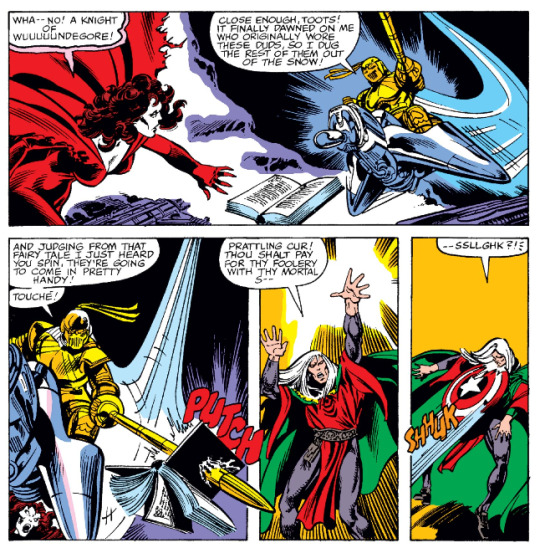
Modred attempts to magic at him but thankfully Modred needs a stanza before getting around to anything which leads him to being SHHUK’d right in the throat with Cap’s shield.
Beast’s flashy entrance was enough to distract Chthon and loosen the bonds on the Avengers. And its a very flashy entrance. That is some snazzy golden armor.
Around this point we get to learn that apparently the primary diet of an ancient Earth-Spirit who had been sealed into a mountain is the scenery. Because Chthon gets downright hammy.
Some examples: “Wha -- no! A knight of Wuuuuundegore!” , “You triiiiicked me!” , “Yesssss! Hurt meeeee! It will only make the paaaaain of your chastisement that much sweeeeeter!” , “Weak souls taste looooovely!”
Aside from the chalky complexion, Chthon also goes increasingly more monster face as this goes on eventually looking like Voldemort with luxurious red hair.
Anyway, with the Avengers free and Chthon promising punishment for Beast’s trickery, Quicksilver just punches Chthon right in the face. Zero hesitation. Usually in these situations you get a dilemma like ‘but thats my friend/teammate/sister! I can’t hurt him/her/them!’ but Quicksilver just runs right up and pops Chthon one.
Good job, Pietro.
Meanwhile, Django Maximoff has an actual heart attack.
What is with Pietro and Wanda’s father figures having heart attacks? And how afraid should Magneto be??
But before Django falls down, he realizes that he’s still carrying that doll he used when he tried to kidnap Scarlet Witch before. He laments the loss of the Nivashi Talisman. If only he still had that he could kidnap Wanda’s soul again. BUT FOR GOOD REASONS THIS TIME.
But... he does? The doll starts moving and speaking with Wanda’s voice.

And then Django falls down in startlement and also having an actual heart attack.
Quicksilver jumps to some conclusions and realizes that the Nivashi Talisman was bullshit, the magic was within Django all along! Or rather, it was the wood that the dolls were carved from that was magical!
Like the Puppetmaster’s radioactive clay, the wood of Wundagore was exposed to the uranium in the mountain and as everyone knows, radiation is basically magic.
Leaping to some other conclusions, Quicksilver grabs the doll and tries to will a swap between Wanda and Chthon’s soul - to trap Chthon in the doll and put Wanda back in her ever-Voldemorting body.
But it doesn’t work because sometimes grabbing a magical doll and hoping for the best just doesn’t pay off.
Quicksilver: “Damn! It’s not working! Nothing is happening!”
Chthon: “Of coooooorse not, mortal! Your will is too weeeeeak! But I don’t mind -- weak souls taste looooovely!”
Quicksilver gives up and apologizes to Wanda for failing but now its Ms Marvel’s time to jump to some conclusions.
Clearly the problem is that none of the Avengers are trained magicians and can’t stand up to Chthon alone! But with the power of FRIENDSHIP maybe, just maybe, they can Care Bear Stare Chthon into defeat!
So the Avengers all touch Quicksilver and he tries again.
But this time, with TEAMWORK and wishing really hard, a powerful pink energy glow suffuses the Avengers.

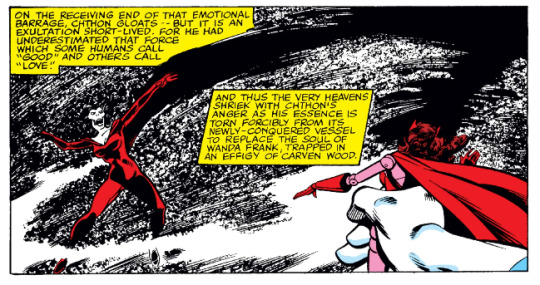
“And thus ensues a literal battle of wills, as six struggling heroes pool their concentration into a phalanx of sorcerous thought, hoping to restore a soul -- and in the process, save a world! On the receiving end of that emotional barrage, Chthon gloats -- but it is an exultation short-lived, for he had underestimated that force which some humans call ‘good’ and others call ‘love.’ And thus the very heavens shriek with Chthon’s anger as his essence is torn forcibly from its newly-conquered vessel to replace the soul of Wanda Frank, trapped in an effigy of carven wood.”
Okay but be that as it may, they basically do a Care Bear Stare.
Jury is out on which Avenger is which bear.
(Cap is Patriotism Bear)
And as Wanda regains her rapidly un-Voldemorting body (I also notice that her evil, sexy costume turns back to normal. Interesting morality indicator...), she yells at Quicksilver to do something with the doll.
So he throws it off the mountain.
Good job, Pietro.
Throwing cursed objects into the distance means they’ll never return to harm anyone ever again.
Okay. I shouldn’t be snide. He throws Chthon!Doll into the crater where Wundagore city was and then Wanda uses a “combination hex bolt and mutant blast” to collapse the mountain on top of the doll.

I thought her hex bolts were her mutant power but whatever.
So Chthon has gone from being trapped in a nether plane to being sealed inside a mountain to being sealed inside a Scarlet Witch action figure underneath a mountain.
I can’t tell if that’s a lateral move or not.
Chthon ain’t pleased either way.
But alas. This victory came at a price. Although Django Maximoff’s magic and belief gave them the key to victory, he died of his heart attack. And never once did he stop loving the twins or ever get their names right.
Wanda and Pietro decide to bury him in the forest that he loved so much.
Dammit, he died too soon!
He may not have been the biological father but he’s the one that helped raise Wanda and Pietro and there’s so much dad stuff he could have done with them! Like awkward thanksgiving dinners with Magneto!
This story makes a big deal about setting up a new, real backstory for the twins and then quickly gets rid of any complications of that new backstory. Django really raised them? He dead now.
Making the Whizzer their dad at least kept the Whizzer around as a possible dadly figure. Also he’s had like five heart attacks and he’s still ticking. Give me back Django!
Anyway.
There’s the question of what to do with Modred. He was so linked to Chthon that without the demon to guide him, he’s become as mindless as an infant.
And there’s no way the Avengers are going to take care of him. They didn’t take care of teaching Loki to poop again when he lost his mind and he was Thor’s brother. Of course they’re going to pawn Modred off on Bova, cow-woman midwife.
She doesn’t mind though. Caring for children is what she was created for and teaching an ancient wizard to poop again is close enough for her.
And with no follow-up to see if Bova has adequate childcare facilities or has adult child proofed her home, the Avengers head off to return home.
Luckily Wonder Man crashed the Quinjet in mostly one piece because they’re not going to be able to borrow a jet in Transia. I don’t think there’s even a train station.
Also, Beast is still wearing the Knight of Wundagore armor and still has the very evil and corruptive Darkhold book just impaled on the lance.

I’m... are you just going to take that home, Beast??!
I think part of the Darkhold is later going to end up in Doctor Doom’s hands and after that the whole thing ends up in the Vatican but its unclear what Beast did with it in the interim.
Anyway, that's the end of a story that we can call Yesterday Quest or perhaps Wanda and Pietro Return Home And It Was Awful But At Least They Met Bova.
I think I’ve been pretty clear about what I think about it. Every time they change the Maximoff’s backstory they just make it even more spaghetti nonsense but this spaghetti nonsense was entertaining and brought us a lot of good stuff like Bova the cow-woman midwife, the High Evolutionary desperately trying to get rid of some babies, the Avengers using the Care Bear Stare, Cap going all the way over Gyrich’s head to the president, Wasp getting to Do A Thing, and Quicksilver falling down a mountain.
I don’t think stuff like Wanda’s magical potential needed a big backstory explanation and it just raises questions about why Pietro wasn’t also tapped as a potential host body and while this isn’t the first time Wanda ends up possessed (its the second and a half) I think it does contribute to an unfortunate trend of Wanda being possessed or going evil and sexy that writers really need to just get over.
I do think its a shame that Falcon still has not had a good showing in the book. Beast got several issues dedicated to what a good Avenger he would be. And I know that Falcon doesn’t even want to be here but he also wants to look good and the more he’s made to look ineffectual the more I can’t help but feel that this is an intentional tactic. It feels like Michelinie had an anti-affirmative action agenda to push and Falcon is both the catspaw and victim of that agenda.
Just let Falcon do cool stuff. I know he’s not long for this team. JUST LET HIM BE COOL.
Aside from that, its neat to see the backup Avengers concept so immediately put into action. With Iron Man busy with his own biz in Demon in a Bottle, Wonder Man is tapped to fill his spot on the team.
Setting up a flexible roster like that offers a lot of interesting possibilities for mixing things up.
Next time: David Michelinie takes a break from writing for a few issues and the Elements of Doom!
Which weirdly have nothing to do with Victor von.
Follow @essential-avengers if you like Bova, think Quicksilver could rock Wanda’s evil sexy costume, or just enjoy this liveblog.
#Avengers#Chthon#Scarlet Witch#Quicksilver#Django Maximoff#Captain America#Ms Marvel#Carol Danvers#Beast#the Wasp#Falcon#Bova the cow midwife#essential avengers#Essential marvel liveblogging#and now wanda's backstory is known and will probably never change again
16 notes
·
View notes
Text
What Steven Moffat Doesn’t Understand About Grief, And Why It’s Killing Doctor Who
NOVEMBER 27, 2013 / TEA LEAVES AND DOG EARS
There’s a popular joke I’ve seen floating around on Tumblr for a while now. It goes like this:
“Joss Whedon, Steven Moffat and George R.R. Martin walk into a bar and everyone you’ve ever loved dies.”
Here’s the problem, though: George R. R. Martin and Joss Whedon are, of course, infamous for killing off the characters that they know are almost universally beloved by fans for precisely the reason that they are beloved and Martin and Whedon know it’ll have huge emotional impact. They pick the harmless bunny of the group and then give them some brutal offing — Tara on Buffy, Wash on Serenity, Ned Stark in A Game of Thrones being an easy handful of examples. But who has Steven Moffat actually killed off?
The two-parter that he wrote during the Christopher Eccleston/Russell T. Davies era literally ends with the Doctor blissfully proclaiming that “Just this once — everybody lives!” In fact, a woman who lost her leg years earlier is restored to bipedalism by space magic. It was an amazing, heartwarming scene specifically because of the first part of that sentence — “just this once.”
everybody lives
But apart from that two-part episode, the Davies era was plenty bloody. While Doctor Who is ostensibly a kid’s show, Davies made it clear that plenty of innocent people have been killed — often en masse — during especially high-stakes alien attacks despite the Doctor’s heroic intervention. And let’s not forget that Davies kicks off the entire reboot of the show by announcing that (nearly) all of the Time Lords and (nearly) all of the Daleks were wiped out by our genocidal and deeply guilt-ridden hero.
That was a hell of a way to re-introduce a popular kid’s show back to the airwaves, but it was perfect. It made the Doctor a new and mysterious character for people who’d never seen the show before, and it changed the way older fans looked at him. You couldn’t just continue down the same old lines and pick things up after all that time without some real change and expect it to work. And the change Davies employed worked beautifully. Until last week, of course — but we’ll touch on that later.
So let’s get back to the central question: who has Steven Moffat killed?
Well, on the last season of Sherlock, fans were reeling when Moffat had the show’s eponymous lead jump to his death, although with the promise that we’d find out how he faked it when the show resumed. So that doesn’t count.
sherlock
Well, what about Moffat’s next Who episode in Series 2, The Girl in the Fireplace? Reinette (Madame de Pompadour) dies, but she dies of old age because — and don’t even get me started on how annoying this concept is — the Doctor ditches her to go back in the fireplace one last time, apparently forgetting that it always results in a huge time jump. So that doesn’t quite count, as Moffat was fulfilling history.
Next up is Blink, Moffat’s first chilling installment of the once brilliant and now sadly tiresome Weeping Angels. Who dies? Well, the nice DI that Sally chats with dies of old age after being displaced in time. The same fate is afforded to Sally’s best friend, but she does manage to write a letter letting us know everything’s pretty much cool, because who wouldn’t want to be taken away from their family and friends to churn butter for 60 years?
But other than that? Nobody. A theme seems to be emerging.
The Silence in the Library and Forest of the Dead? Well, Moffat does kill off River Song and her whole crew, but then has their souls uploaded onto the library server so that they’ll never “truly” die. Again, it’s an extremely softened death, similar to the “old age/time displacement,” in that it’s sad but any real cause for grief has been removed.
Then Moffat, of course, took over the show as show runner. And once again, people just seem to keep… not dying. Part of the problem is that Moffat’s a big fan of the Giant Reset Button — so much so that he literally wrote in a Giant Reset Button into the episode Journey to the Center of the TARDIS. One step above the “It was all a dream” plot, the Giant Reset Button absolves the characters and the writers of any repercussions and they can carry on as they were, even though we, the audience, saw a “major event” that is evidently no longer relevant. You can have your fun and adventure, but you need not learn or grow or change from it.
friendly
Other notable not-deaths include any time Rory “died” in the series, the almost-people clones, the Doctor himself during the impossibly confusing 6th series finale, Vincent Van Gogh and, finally, The Ponds who were killed off exactly the way Sally’s security guard almost-lover in Blink was — by being displaced in time in such a way that the Doctor, for hand-wavey reasons, couldn’t just go pick them back up again and they seem to do just fine living in the past because they have each other, I guess.
All of this is leading up to my biggest problem of all: the recent 50th Anniversary Special in which Moffat, not merely content to sap any trace of blood or death or grief or loss from his own era, removed the basis of the show’s reboot plot:
big button
The mass genocide that the Doctor committed — all the people he killed and all of the times he wrestled with that decision and was forced to come to the conclusion that it was for the best — simply never happened now. All of the amazing episodes in which the Doctor, overcome with grief, spoke about the tragic necessity of his decision are rendered meaningless by this newly-invented War Doctor who allegedly “didn’t count” until now. Now he counts. Maybe. Because of the magic of love and Bad Wolf.
Now of course you can argue that the show plays with time constantly, and that it’s possible that this is a new time stream in which it didn’t happen, and that’s all well and good. But the fact of the matter is that from this point on, the Doctor is no longer complicated by this event. Moffat, who has never had the best track record with character development as it is, has actively written a plot which removes an enormous amount of change and progression from the show’s lead character.
But more importantly than that, when you have no death, when nothing truly has weight or scale, when decisions don’t stick and nobody feels the consequences… it’s hard to care about anything. The stakes on the show feel so low at this point that a once addictive program is unengaging, dull and hollow. Even the 50th special had no real gravitas because we were basically watching a plot be un-done, rather than made. We were watching a character be un-banished, rather than created. For a celebration of 50 years of a television show, it felt awfully like a celebration of a writer who’s only been running it for 4 years. And, perhaps most irritatingly for a Davies fan, the complete erasure of everything that was developed during that previous era.
I don’t think it’s an insult against Davies, though — Moffat does it constantly to himself. Amelia Pond grows up without parents because they were erased by a crack in space and time. When they are restored to her by virtue of yet another giant re-set button, we never see them again. Amy rarely talks about them. You cannot have a character whose parents were taken from her at a young age, who then gets them back — and remembers that she had lost them in the first place — and not see a perceivable change in said character. Similarly, you cannot rob that character of her baby, remove her ability to have children, and have the biggest consequence be that she becomes a model who’s moody with her husband for his own good.
model
Or take the latest companion: Clara cannot live and die hundreds of times for her good buddy the Doctor (who she’d known for, what, a month?) and then basically brush it off like it’s nothing.
We can talk for days about Moffat’s other problems as a writer — the sexism, the homophobia — and those are all valid complaints, but what will always be my biggest gripe is his fear of consequences. When you cannot deal properly with grief or loss or change, you cannot write believable characters or interesting stories. And as long as this show lacks believable, real, characters and engaging stories, it will continue to suffer. So please, for the good of Doctor Who, shed a little blood and actually deal with it. Revel in consequences. Let your human characters behave like humans. In short: restore the heart to a dying show.
435 notes
·
View notes
Text
7 Business AI Insights Every CEO Must Know
Share with others: Facebook | Twitter | LinkedIn | Google+
Business AI has broken into the mainstream
2016 was the breakthrough year for personal and business AI regarding the mainstream press coverage. Probably the biggest news was Google’s AlphaGo AI beating a human in the game of Go. The reason why this is such of an achievement is that Go is brutally hard for computers. It involves almost an infinite amount of different combination of moves, which makes it next to impossible to use traditional brute force solutions that calculate all the possible combinations then picking the best course of action.
The saga of AI beating expectations continued in early 2017 when AI was able to do another feat deemed near impossible for our current AI tech. Artificial intelligence beat professional players in Texas Hold’em poker. Compared to Go, poker introduces a whole new level of difficulty because it requires a certain amount of intuition and imagination. It’s not only finding a way to compute the next move efficiently; it’s about creating an AI that can guess reliably what cards the other players might have.
The ability to have intuition and imagination in AI has profound implications for business applications of artificial intelligence.
How to assess artificial intelligence and its progress
Artificial intelligence can be divided into two camps: narrow AI and general AI. Also, the names weak and strong AI are being used. When you watch films like Her or 2001 Space Odyssey, what you see is general AI. We are not even close to that, and many argue that general AI will not even be necessary. It is also fairly obvious from the numbers where all the action is.
> Current predictions tell us that only 0.5% of cumulative revenue share between 2016 and 2025 will occur in companies developing general AI.
Many pundits predict that we will soon enter the Gardner hype cycle's “the trough of disillusionment”. If that happens, it will come mostly from the public’s expectations of AI being general AI when almost all companies in the industry are working on narrow AI.
Narrow AI is essentially highly specialized AI for a specific purpose. Imagine the most brilliant mathematician or developer who literally faints if there’s a need for social interaction. They are stunningly brilliant in one domain and completely fail at others. That is what narrow AI is.
If you are new to AI, it might come as a surprise, but narrow AI applications already surround us. If you have ever listened to music from Spotify’s “discover weekly” playlist, viewed an item based on Amazon’s recommendations, or talked to your mobile phone’s assistant, you have already worked with narrow AI. They are not always brilliant, but they are here.
People often expect some godlike abilities from artificial intelligence, but in practice, for AI to be adopted it only needs to be a little better than humans at performing the same task.
The real-life requirement of AI being just a bit better than human counterpart is why self-driving cars and other types of servant robots are inevitable. They do not need to be better than human beings in every way; they only need to perform the job better and cheaper than a human counterpart would.
The author, Arthur C. Clarke once said that any sufficiently advanced technology is indistinguishable from magic. This is why we will not notice narrow AI until it is everywhere and we start to reflect on the near past.
If you look at your dishwasher now, you might think it is something incredibly basic, and you remember how annoying it was to wash dishes by hand in your younger years. But if you could get your hands on a time machine, jump to the 1920s, and demonstrate your dishwasher to somebody in that period, they would be amazed beyond words by this magical robot. This exact same phenomenon will happen with personal and business AI.
I call this phenomenon invisible adoption of artificial intelligence.
1. The invisible adoption of personal and business AI
The invisible adoption of artificial intelligence will make it look as nothing is happening, and suddenly within few years, we wake up only to find out that AI is in the majority of products and services we consume.
Businesses will use artificial intelligence to deliver their everyday value propositions, and we won’t even blink twice when our only contact with a company is with an AI-powered customer service.
Think at the end of the 90s and how mobile phone adoption now seems like it just exploded — suddenly everybody had one. The same thing will happen with personal and business AI, but this time it will happen inside products and services, so we will not notice it so clearly.
Business owners will face the incredibly hard challenge of transforming their products and services to benefit from business AI.
The leap that companies will see coming but majority will not take in time
During this decade we have already seen how hard it has been for companies to implement “digital transformation.” Most companies ordered a website built on top of CMS, started using online CRM, installed visitor analytics, bought some online advertising, maybe hired an agency to do search engine optimization, and called it done. AI will make it painfully visible that digital transformation means digitalizing all company processes, not only extending company’s presence into the digital world.
Companies without proper digitalization will not be able to benefit from AI because all AIs live and die by the data they have.
I predict that we will see a record amount of bankruptcies in the coming ten years driven by markets adopting business AI one way or another.
If you want to stay updated about all things that you as a business owner need to know about business AI, leave your email below and I’ll send you an update when something important happens.
[wd_hustle id="future-updates-inline"]
Now that you understand the difference between narrow and general AI, and you know the basics of how AI adoption will happen, let’s talk about what you need to know about business AI.
2. AI in business applications is starting to happen
The biggest push we are witnessing right now is AI being adopted by business applications. There’s virtually no industry where applications could not be more intelligent.
The dreams of artificial intelligence assisted work have been floating in business world’s collective consciousness since the 70s, but now they are finally becoming a reality.
Envision a world where your tools give you better recommendations based on your preferences; predictions and insights are automatically extracted from your business’ data; your AI accountant takes care of the financials; you enjoy effortless, automated AI scheduling; AI prioritizes your daily activities in the most optimal way based on how you like to work, and your sales meetings are analyzed by an AI to find where to improve the pitch. Sounds good, right?
Intelligent apps will not only make business processes more efficient, but they will also make your employees happier. For example, AI can already help with unconscious discrimination. You can delegate repetitive tasks to the AI-powered machines and staff can focus on tasks that require human judgment.
What tasks people are doing will change radically in the very near future. Provided with enough training data, narrow AI surpasses humans in many prediction tasks already. As the time passes, algorithms improve and computing resources increases, AIs will be able to predict longer and longer chains of events. Jobs that require taking an input and performing a quick prediction will be turned to AIs.
Jobs that require more comprehensive judgment about what the prediction means and what actions should be taken based on it will remain in the human realm for a while still.
Gartner predicts that significant majority of the world’s 200 largest companies will use AI-driven features in the very near future. The majority of the apps will be AI-driven by 2020.
In the next few years, implementing AI in services & products will become a required core competency for the vendors. Business AI won't be just "a feature" in business applications, it will become "the feature".
3. Artificial intelligence in customer service
Chatbots made some splashes in the media in 2016 when Facebook started to promote their Messenger platform for bots heavily. The marketing push was a little premature, and Facebook caused much damage to the image of chatbots. The technology was not there, and the new paradigm of conversational user experiences turned out to be hard to pull off for UX designers who were used to working on apps.
Bad user experiences caused chatbots to become almost a joke in the press and consumers did not see the benefits. A year later, it is rare to find somebody who prefers to use any of the over 10000 Messenger chatbots available, but there are few examples already where artificial intelligence in customer service works.
However, it would be a mistake to forget chatbots because of the rough start. Jim McHugh, Vice President and General Manager of NVIDIA predicts that in 2017 there will be a chatbot that produces such human-like responses that an average person cannot tell if it is a human or a machine. This advance will cause an AI avalanche in the customer service industry.
I predict that we will see the first fully AI-driven frontline customer service team by the end of 2017. After the initial hurdles, customers will not notice the change from humans to AI because they will not be able to tell that they are communicating with a machine. At the beginning there will be many limitations to how much AI can do for the customer. We still haven’t figured out how get AI to follow up a long chain of related events with enough reliability for an actual real-life business use.
How it works in practice, is that once a chatbot cannot figure out what to do next, it will pass all the data it has collected on the customer’s case so far to a customer service person who will then solve the problem. There are already companies like alphablues who provide this functionality with their chatbots.
In a survey done in the UK, 60% of responders felt that live chat was the appropriate communication channel with a retail business.
The general public is getting comfortable with chat-based communications with companies more and more every year. This is good news because in a phone-based customer service, bouncing customer back and forth between representatives can cause friction and frustration for the customer. In the live chat, the change from chatbot support to human support happens in an instant.
At the end of 2016, Microsoft’s AI team announced a historic achievement of reaching human level accuracy in recognizing the words in a conversation. Now, AI teams all over the globe are focusing on developing AI that can understand the meaning behind the words.
Once our AIs can understand the meaning behind our sentences with enough accuracy, we can automate certain customer service interactions altogether.
On a more worrying note, Forrester predicts that chatbots will create lost wages of $262.7B annually by 2021. They also predict that AI and other intelligent automation will replace 16% of US jobs by 2025. At the same time, they estimate that AI could create new jobs equal to 9% of the workforce.
I think 9% is a very optimistic prediction. Historically, the number of new jobs created by new technologies, especially disruptive ones, has been tiny compared to jobs that suddenly are not needed anymore.
As discussed before, most of the jobs that will turn obsolete will be jobs that either requires only predictive skills that AI can replace easily, or muscle/action based skills that robots powered by AI can replace easily. Jobs that require a valuable judgment of some sorts will be safe.
3. Harnessing business AI in decision making, predicting and forecasting
The year 2016 will be imprinted in the history as the year when everybody predicted US election results completely wrong and the candidate who was not supposed to have any chance of winning ended up winning. Even though AI did not play any part in the actual presidential race, it was a very public prediction failure for many respected research organizations which use AI and various statistical techniques to make predictions out of huge piles of data.
The failure to predict such a big event has rippled into 2017, and we are seeing a lot of research funding going into the area of AI prediction.
Interestingly, there was a healthcare startup called Genic, whose AI predicted that Trump would win over Clinton a few days before the election, despite all polls being against it.
The recent advances in infusing AI with more long-term memory and a capability of understanding multiple tasks will eventually lead to a whole new category of business AI prediction and forecasting tools. These tools will assist executives in complex strategic questions with answers and predictions that take into account all the data available.
Compared to humans, machines can focus on one task indefinitely. This means that while business owners are running out of steam after many hours of pondering a hard question, AI will continue crunching in the background. This will amplify and expand business’ ability to choose the most optimal strategic route in ways we can’t even predict yet. We are already starting to see examples how artificial intelligence is used in the finance sector to augment lawyers.
One of business AI's true value propositions is that it will enable companies to operate in unfamiliar territories without pre-existing knowledge. This means that businesses can use artificial intelligence to simulate possible scenarios without having concrete data of the circumstances. AI will simply use its existing data to extrapolate a different scenario.
We already have AIs that can take a chain of data and predict into the future. They are currently used mostly for translation and text generation, but in the future, the same underlying concepts will be used to simulate very complex business scenarios.
Improved prediction powers are also driven by the emerging field of BOI (Behaviors of Interest). Companies in the industries like customer experience, healthcare, engine performance, self-driving vehicles, manufacturing, and cyber security are in the constant need of better prediction capabilities to spot trends, anomalies, and other BOIs from the data generated by their products and services.
4. Artificial intelligence in HR for happier employees
Companies big and small are always struggling with HR related metrics and processes. A few years ago, when big data was all the hype, there was a push towards “people analytics” and other HRMS (Human Resource Management Software) systems. Collecting data and integrating systems to produce reports has helped businesses to have a better overall view of their employees, but very little has happened to decrease turnover and attrition.
Traditionally, HR has been very much led by psychologists applying science to workplace issues. With all the progress with business AI, more and more HR companies will adopt artificial intelligence to enhance their processes.
Large corporations using HRMS already generate workforce data in such large amounts that human HR specialists cannot keep up with it. AI is expected to help with data processing and creating personalized HR plans for each employee.
In 2014, AI called Ellie, demonstrated that humans like to open up to a machine better than to another human. In the test conducted by a research team, Ellie emulated a psychologist with 239 people. Half of the people were told they were having a therapy session with a person via a 3D avatar and half of them were told the truth.
When test subjects communicated with Ellie, it analyzed their facial expressions for sadness after it asked participants sensitive and intimate questions.
After the session, test subjects evaluated how comfortable they were at disclosing private issues. To help counter subjects' self-evaluation biases, transcripts of the sessions were also analyzed by three human psychologists.
The result was that the group who thought they were communicating with a machine felt more comfortable disclosing personal issues, and in the end, less sadness was detected.
The Ellie experiment demonstrates that humans can be comfortable talking to a machine as long as it helps them as well as a human would. From a business perspective, Ellie paves the way for AI in HR services, like AI work psychologists to help avoid burnouts or an AI to fight against discrimination in the workplace.
5. The great division of AI companies: AI startups versus AI conglomerates
The big five players in AI right now are Google, Facebook, Amazon, Microsoft, and IBM. The big players are all mostly aiming for AI solutions that are the most scalable like, for example, AIs for the health care industry and all sorts vision related AIs. These tasks are very computationally heavy and require enormous datasets, so only the big players have enough resources to tackle these challenges. There’s also been a wave of M&As lately targeting startups competing with the big players. More will follow when incumbent companies who missed the boat will desperately try to grab in-house AI expertise by buying promising startups.
While the big players are busy tackling challenges requiring enormous datasets and warehouses stacked with computing power, there’s a door open for startups to develop heavily specialized solutions for small and medium-sized companies. The majority of these solutions work mostly based on customer’s data, so the playing field is suddenly even between startups and big players.
A level playing field in the specialized AI solutions is excellent news for business all over the globe.
“We will move from mobile-first to an AI-first world.” -Sundar Pichai, Google’s CEO
Even though the big five have dominated the press lately, products and services from a rapidly growing AI startup scene are starting to blossom. Investors are investing at an almost exponential rate, and new AI startups are being founded with an extraordinary rate. A big part of AI startups is focusing on business AI which is great news for us.
If you would like to stay up to date with the latest and most exciting AI startups, leave your email below, and I'll send you an update when something new and exciting arrives.
[wd_hustle id="future-updates-inline"]
If the motto in the 2nd industrial revolution was to take a tool and make it electric, the motto in the coming years is to take almost any existing tool and apply AI to it.
6. Artificial intelligence will be in every product
There’s an incredible push currently underway to grab the dominant market share in the brand new AI specialized CPUs and purpose-built AI computing platforms market. NVIDIA, Intel, AMD, and Microsoft have all introduced their horses to the race. Unlike the traditional CPU and GPU market, the AI computing market is still open for newcomers, and because of this, relatively unknown companies like Cray are joining the race. Even Google has talked about their in-house crafted hardware solutions and the possibility of bringing them into the market.
Most product companies will not have any excuses for not making their products intelligent
Companies who want to apply AI to their products will need to get their hands on AI chips meant for embedding. These chips are specialized solely in running an existing AI models that produce output based on the user's input. Training your AI will still happen in the cloud or with your own computing systems.
Competing technologies and economies of scale will soon push the price of the AI chips so cheap that most product companies have no excuses for not making their products intelligent.
The demand for intelligent products is already visible. For example, in social media, many people have been amazed at how their children would rather play with Amazon’s Alexa than with their toys. The preference for "toys that talk like humans" gives a glimpse at how products that react to our feedback in the most natural way possible will take over the market. Most consumers do not currently wish for an intelligent hammer, but they will change their minds after they have tried one.
Intelligent tools will shift the burden of knowing what to do from the user to the tool
We are most likely the last generation that will have physical tools that don’t, at the minimum, collect data about how we use them or personalize themselves for our preferences.
At CES 2017, L'Oreal revealed a smart hairbrush that records the quality of the user’s hair and helps users to improve their brushing technique. For most people, a smart hairbrush sounds ridiculous, but try to see this as the first step of something bigger and start imagining few years ahead when we have smart combs that can detect changes in your hair that might indicate an illness. Suddenly, the small and seemingly ridiculous products start to make sense.
The bottom line is that whatever your product or service is, now is the time when you should start paying attention to how you can improve it with AI and sensors.
Another positive trend is the standardization and availability of AI development tools. The big players like Google and Microsoft have all released their AI development frameworks and accompanied them with cloud computing services where you can run your AI. The availability of free tools and relatively affordable platforms to train them on effectively makes AI development a possibility for everybody from high school students to Fortune 500 companies.
In the near future, we will see a sort of compatibility layer built on top of different tools to help developers combine various AIs constructed with various technologies into an AI that is more the sum of its parts.
7. AI in business intelligence
AI in business intelligence won’t be only about smarter predictions and insights. It’s also about making business intelligence easier to use for non-tech savvy people. BI tools with interfaces that can parse your questions into insights and predictions will be soon the de facto way of getting information about your business.
Companies who drop the ball with AI-powered business intelligence will soon find themselves with competition that can sell better, produce better, recruit better and do it all without breaking a sweat
Firms that are thinking about investing, or have already invested, in an in-house data science team to help with business intelligence know that around 70% of the team’s time is spent on cleaning the data. Rest of the time goes into selecting the right algorithms and then finding the correct parameters for the chosen algorithms for the data that’s being processed. Some machine learning practitioners describe tuning the algorithm parameters as a “dark art.”
Making data science more efficient is obviously a huge interest for the whole industry, and we are making progress towards the automation of certain processes. Research in automated machine learning has created several open-source projects that are now being used successfully to select algorithms and tuning the parameters automatically. The cost savings from reducing time spent on parameter tuning alone are enormous.
Automated machine learning has been slowly progressing, mostly behind the scenes. Now that business AI is in the news, big data has established itself as a norm, and companies are spending on business intelligence tools, expect to see much more happening in the field of automated machine learning.
Conclusion
2017 will be a fascinating year for business AI. While the public will be inevitably disappointed by AI due to wrong expectations set by the press, businesses have already started to jump on AI to protect their long-term survival.
More and more business applications will be powered by AI, and more and more companies will "bite the dust" when competition runs AI-powered circles around them.
From major areas inside a business, people related functions like customer service & HR will be the most likely candidates to experience radical enhancements from AI-powered solutions. Business intelligence will experience more gradual growth while marketing and sales' AI is getting an enormous push from small marketing and ad tech startups.
Products will start to have intelligent features, and they will begin customizing themselves according to user’s preferences.
Competition in the AI hardware market is heating up, and that will result in cheaper and faster AI chips both for embedding into products and for purpose-built AI computing platforms.
Developing AI will become more standardized, and cloud computing offerings are making it possible for everybody to develop their business AIs. Data science and business intelligence will enjoy more automation around hard-to-get-right processes, and companies will enjoy more efficient data science teams.
Original post: 7 Business AI Insights Every CEO Must Know at AI in Businesses - Machian Future
0 notes